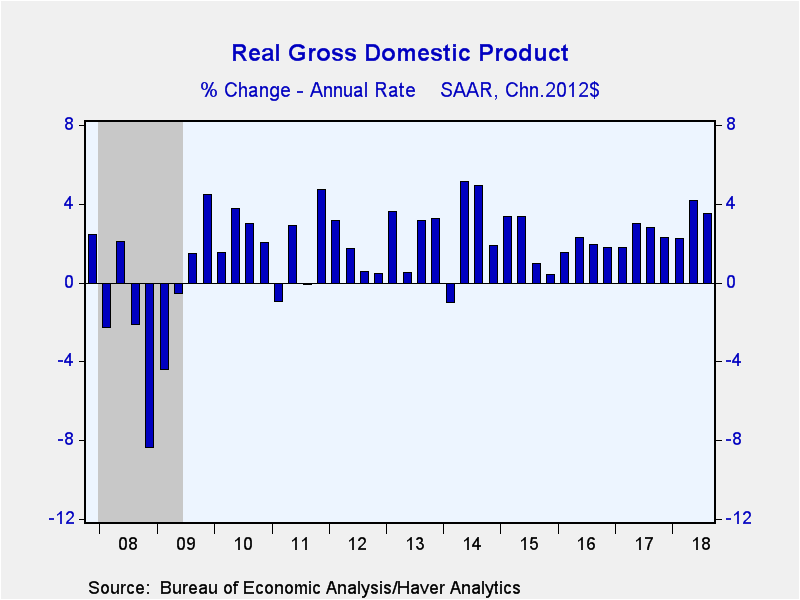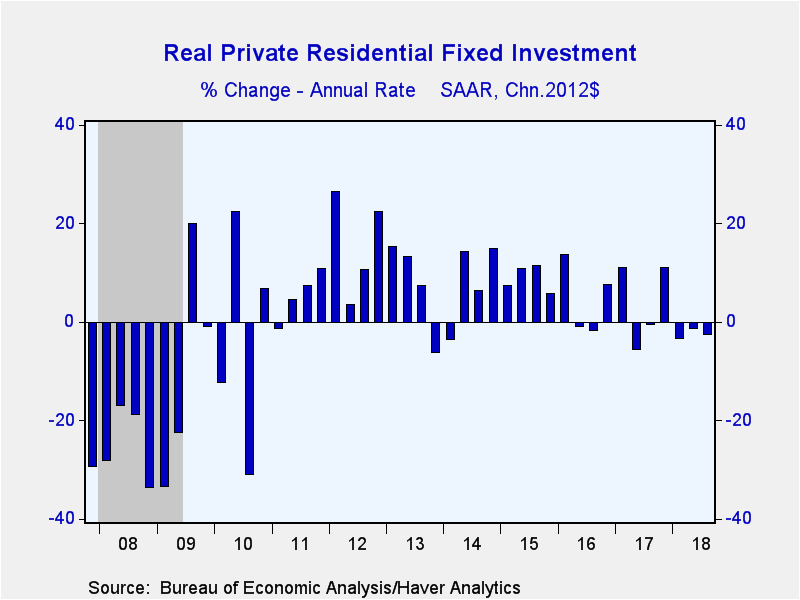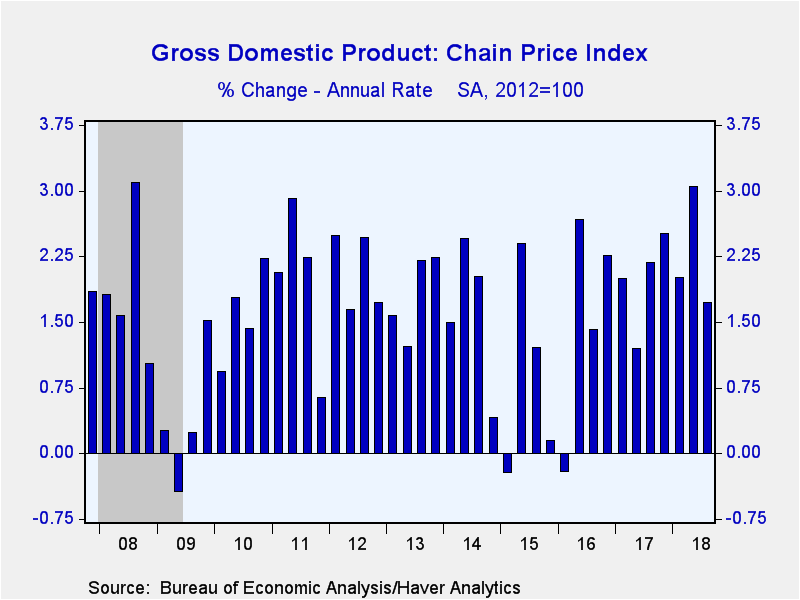 Global| Nov 28 2018
Global| Nov 28 2018U.S. GDP Growth Is Unrevised; Profits Growth Improves
by:Tom Moeller
|in:Economy in Brief
Summary
Real gross domestic product increased 3.5% (AR, 3.0% y/y) during Q3'18, unrevised from the advance estimate. It followed a 4.2% rise during the second quarter. A 3.6% advance had been expected in the Action Economics Forecast Survey. [...]
Real gross domestic product increased 3.5% (AR, 3.0% y/y) during Q3'18, unrevised from the advance estimate. It followed a 4.2% rise during the second quarter. A 3.6% advance had been expected in the Action Economics Forecast Survey.
Accompanying the report was the initial indication of after-tax corporate profits, which rose 3.3% (19.4% y/y) including adjustments for inventory valuation and depreciation. The rise followed 2.1% growth in the second quarter. Profits without inventory & depreciation allowances rose 0.7% (5.9% y/y) following a 3.3% Q2 increase. Domestic nonfinancial sector earnings grew 5.1% (15.8% y/y) but financial sector earnings eased 1.7% (-9.0% y/y). Foreign sector profits increased 3.7% (8.7% y/y).
Growth in domestic final sales of 3.1% (3.3% y/y) was unrevised. Personal consumption expenditures was lessened to 3.6% (3.0% y/y) from 4.0%. Spending of durable goods was reduced to 3.9% (5.6% y/y) from 6.9% as motor vehicle purchases fell 1.5% (+1.6% y/y) instead of rising modestly. Recreational vehicle purchases growth was reduced to 9.1% (9.4% y/y) and spending growth on home furnishings of 6.8% (6.5% y/y) was revised slightly lower. Nondurable goods purchases surged 5.3% (3.3% y/y) which was little-revised. Clothing purchases strengthened 11.2% (5.3% y/y), the quickest growth since Q4'05, and food & beverages expenditures rose an improved 3.8% (3.7% y/y). Gasoline & fuel oil buying declined 1.2% (-0.4% y/y). Spending on services improved a little-revised 3.1% (2.4% y/y). It remained the quickest growth since early 2015. Outlays at restaurants surged 7.0% (4.2% y/y) which followed an 8.1% Q2 rise. Together these growth rates are the strongest in 25 years. Health care outlays increased 4.2% (2.5% y/y) and financial services insurance rose 1.0% (0.4% y/y). Housing & utilities outlays gained 1.1% (1.5% y/y) but recreation spending eased 0.2% (+0.9% y/y).
Government sector spending also was reduced to 2.6% (2.3 y/y) from 3.3%. Federal government outlays grew a steady 3.5% both q/q and y/y. National defense spending strengthened 4.9% and the 4.2% y/y increase was the strongest since 2009. Outlays by state & local governments grew a strengthened 2.0% (1.5% y/y).
Countering the downward revisions was strengthened 2.5% growth (6.8% y/y) in business fixed investment, initially estimated at 0.8%. Structures investment is shown to have eased a lessened 1.7% (+6.8% y/y). Industrial equipment spending advanced 9.8% (4.6% y/y), while information processing equipment investment grew a strengthened 7.4% (9.7% y/y). Transportation equipment expenditures declined 3.9% (+5.2% y/y). Investment in intellectual products was lessened to 4.3% (7.3% y/y).
The fall in residential investment was lessened to 2.6% (+0.8% y/y) from -4.0%. It remained the third straight quarter of decline.
The chain type GDP prices index was unrevised at an expected 1.7% (2.3% y/y), following a 3.0% increase. The 1.5% rise in the PCE price index was the weakest in a year, but the business fixed investment price index remained firm at 1.5% (1.2% y/y), the quickest growth in roughly four years. The residential investment price index increased 3.6% (5.7% y/y), roughly half the growth during the prior two quarters.
The GDP figures can be found in Haver's USECON and USNA database. USNA contains virtually all of the Bureau of Economic Analysis' detail in the national accounts. Both databases include tables of the newly published not seasonally adjusted data. The Action Economics consensus estimates can be found in AS1REPNA.
The Federal Reserve's Framework for Monitoring Financial Stability is the title of today's speech by Fed Chair Jerome H. Powell. It can be found here.
Tom Moeller
AuthorMore in Author Profile »Prior to joining Haver Analytics in 2000, Mr. Moeller worked as the Economist at Chancellor Capital Management from 1985 to 1999. There, he developed comprehensive economic forecasts and interpreted economic data for equity and fixed income portfolio managers. Also at Chancellor, Mr. Moeller worked as an equity analyst and was responsible for researching and rating companies in the economically sensitive automobile and housing industries for investment in Chancellor’s equity portfolio. Prior to joining Chancellor, Mr. Moeller was an Economist at Citibank from 1979 to 1984. He also analyzed pricing behavior in the metals industry for the Council on Wage and Price Stability in Washington, D.C. In 1999, Mr. Moeller received the award for most accurate forecast from the Forecasters' Club of New York. From 1990 to 1992 he was President of the New York Association for Business Economists. Mr. Moeller earned an M.B.A. in Finance from Fordham University, where he graduated in 1987. He holds a Bachelor of Arts in Economics from George Washington University.












